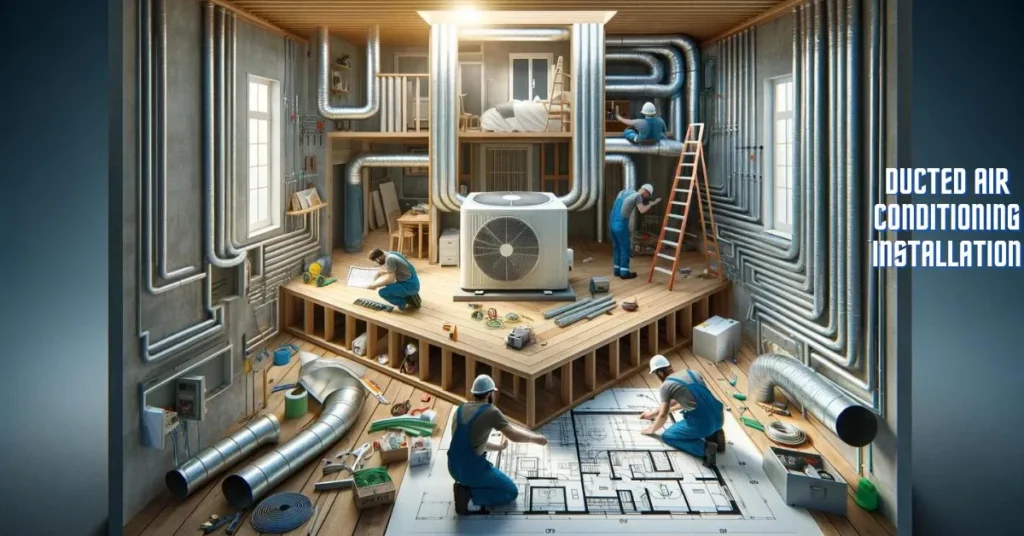Ducted air conditioning systems are becoming more popular in both homes and businesses because they can cool or heat a whole building easily. But putting in a ducted air conditioning system costs a lot of money and needs a lot of thought and planning. Ducted air conditioning systems consist of a central unit, typically located outside the building, which is connected to a network of ducts running throughout the property. Air is cooled or heated in the central unit and then distributed through these ducts to various rooms via vents or grilles.
Contents
Assessment and Planning:
The first step in ducted air conditioning installation is a thorough assessment of the property. A qualified technician will evaluate factors such as the size of the space, insulation levels, existing ductwork (if any), and the layout of the building. This evaluation helps find the best system size and configuration for the best results.
Selecting the Right System:
There are different kinds of ducted brisbane air conditioning systems, from ones that only cool one room to ones that cool more than one room. As the name suggests, single-zone systems cool or heat the whole building evenly, while multi-zone systems let you control the temperature in different rooms or zones. Choosing the right system depends on factors such as budget, space requirements, and desired level of control.
Installation Process:
Once the assessment is complete and the system is selected, the installation process can begin. This typically involves several key steps:
Ductwork Installation:
Ducts are installed throughout the building to distribute air from the central unit to each room. Careful planning is required to ensure proper sizing and placement of ducts for optimal airflow.
Placement of Equipment:
The central unit, as well as any indoor units or air handlers, are installed in suitable locations. Outdoor units are usually placed in an inconspicuous area away from bedrooms or living spaces to minimize noise.
Electrical Wiring:
Electrical wiring is installed to power the system and connect the indoor and outdoor units. This step must be performed by a licensed electrician to ensure compliance with safety regulations.
Testing and Commissioning:
After the system is installed, it is carefully checked to make sure all of its parts are working properly. This includes making sure there are no leaks in the pipes, that air is flowing properly, and that the temperature settings are correct.
Considerations and Challenges:
Ducted air conditioners installation can present certain challenges depending on the property’s layout and existing infrastructure. Some common considerations include:
Space Requirements:
Ducted systems require ample space for ductwork, air handlers, and the central unit. In properties with limited space, alternative cooling or heating solutions may need to be considered.
Duct Design:
Proper duct design is crucial for efficient airflow and temperature distribution. Factors such as duct size, layout, and insulation must be carefully considered to minimize energy loss and maximize performance.
Zoning Options:
For multi-zone systems, determining the number and location of zones is essential for achieving optimal comfort and energy efficiency. This may require additional planning and customization during the installation process.
Existing Infrastructure:
Retrofitting ducted air conditioning into an existing building can be more challenging than installing it in new construction. Factors such as access to wall cavities or ceiling spaces and compatibility with existing HVAC systems must be taken into account.
Maintenance and Care:
Once the ducted air conditioning system is set up, it needs to be serviced regularly to make sure it works well and lasts a long time. Among these are:
Cleaning Or Replacing Filters:
Filters should be regularly cleaned or changed to keep dust and other debris from building up and blocking airflow, which can make the system work less well.
Duct Cleaning:
Clean your ducts on a regular basis to get rid of germs and dirt that have built up over time. This makes the air inside your home better and the system works better.
Test Drives And Tune-Ups:
Professional tune-ups and checks should be done once a year to find and fix any problems before they get worse and cost a lot to fix.
Conclusion:
Installing ducted air conditioning is a difficult job that needs careful planning, skill, and attention to detail. Homeowners and property managers can make sure the installation goes smoothly and successfully by knowing the important things to think about and the steps that need to be taken. This will ensure efficient cooling or heating and long-term comfort. You should talk to a trained HVAC professional before installing a ducted air conditioning system in a new building or adding one to an existing home. They can help you figure out what you need and make sure you get the best results. With proper installation and maintenance, ducted air conditioning can provide reliable and energy-efficient comfort for years to come.











